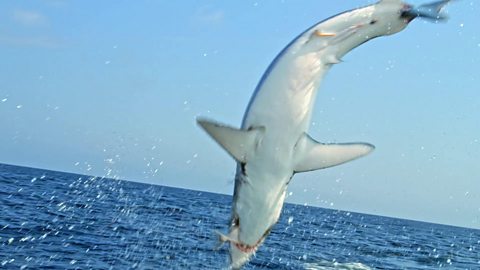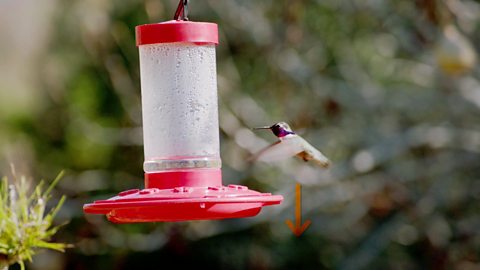ANDY TORBET:Welcome to Beyond Bionic on ±«Óătv Teach. I'm Andy Torbet, the show's presenter. In each episode I take on some of nature's best athletes and try and match their super skills.
ANDY TORBET:And here's what happened when I get into a high-pressure situation with a giant spider crab.
ANDY TORBET:It's time to say konichiwa, which is Japanese for hello, to this. The giant Japanese spider crab. This is the biggest crab in the world.
ANDY TORBET:Their bodies can grow as big as a basketball, and their leg span, from tip to tip, can be up to 4 metres. That's two and a half times my height.
ANDY TORBET:'But their most amazing skill 'is the ability to live in seriously deep parts of the ocean.'
ANDY TORBET:Japanese giant spider crabs have been found living at up to 600m deep.
ANDY TORBET:'They're specially adapted to live at extreme depths 'and survive the huge pressures down there. 'Which makes them masters of the deep.'
ANDY TORBET:And my challenge is to find the technology that will allow me to survive at those sorts of depths.
ANDY TORBET:'I've been set the ultimate spider crab challenge. 'I need to match the mighty spider crab's skill, 'in withstanding intense pressure.
ANDY TORBET:'When we're standing on land, 'our bodies are subjected to the pressure of the atmosphere above us. 'We call that one atmosphere, or one bar of pressure.
ANDY TORBET:'For each 10 metres we dive we add another one bar. 'So down at 600 metres, the pressure is 61 bar.
ANDY TORBET:'That amount of pressure is like the crab 'being able to support 115 elephants standing on top of it.
ANDY TORBET:'And if I'm going to be successful, I'll need to find something 'that allows me to withstand this extreme pressure.
ANDY TORBET:'To find out what it feels like 'to be submerged under a huge volume of water like a Japanese spider crab, 'I've come to Italy, 'to visit Y40, the deepest swimming pool in the world at 40 metres.
ANDY TORBET:'But there is a way I can get down to the bottom.'
ANDY TORBET:Okay I've got all my diving equipment on, and on my back is my air supply. I'm going to take a plastic bottle with me.
ANDY TORBET:'And I'm taking it with me 'to show you the incredible effect that water pressure can have.'
ANDY TORBET:The deeper I go, the more water is above me, and it's the weight of that water pressing down that creates the pressure that's squeezing the bottle. You can see the damage it's done already.
ANDY TORBET:The air hasn't gone anywhere, it's still in there. It's just been compressed by the pressure into a much smaller space. And that causes the bottle to collapse.
ANDY TORBET:'I've reached the bottom and that is only possible 'because I'm wearing my specialist diving kit.'
ANDY TORBET:The pressure around me is forcing the nitrogen from my lungs into my blood and tissues. It's even forced into my brain! And that slows down how my brain operates.
ANDY TORBET:'Crabs are totally unaffected by this, 'because their bodies are designed 'to withstand the water pressure acting on it. 'Keeping their brain and their other organs safe.'
ANDY TORBET:If I'm going to match the spider crab, my regular diving gear just isn't good enough.
ANDY TORBET:'The good news is that there is some wearable tech in Canada, 'which will allow me to dive down to 610 metres, 'matching the Japanese spider crab.'
ANDY TORBET:And it looks like an armoured space suit. What it is, is a submarine that you can wear.
ANDY TORBET:'I know this suit can withstand the huge amount of pressure 'the Japanese spider crab faces.' Okay this is it. 'But can I manoeuvre underwater just as well?
ANDY TORBET:'To do that I'm going to have to be able to move around in it 'using these thrusters, 'and grab using these special claws.
ANDY TORBET:'The first test is all about grip. 'I need to use my claws to open a valve.
ANDY TORBET:'It's vital this suit can let me use or move around so freely 'as it's used by deep sea engineers to work on oil rigs and pipes.' I'm just trying to turn this wheel, which on the surface would be a very, very simple task.
ANDY TORBET:Underwater it's proving a little bit difficult. 'But after 12 minutes of focus and determination, 'I complete my second full turn of the wheel.
ANDY TORBET:'Japanese spider crabs also have grippy claws 'which are used for eating and protecting themselves.
ANDY TORBET:'Up next, my ability to arrange. 'I have to find six broken shapes 'and put them back together to make two letter Bs.'
ANDY TORBET:Okay we've got one, we've got one.
ANDY TORBET:'On the sea bed, crabs will gather and arrange items in this way, 'in order to build their homes. 'And I'm starting to realise how tough it is to work underwater.'
ANDY TORBET:There we go, not perfect but I can tell what two letters they are, and hopefully so can you.
ANDY TORBET:'This final task is all about twisting 'and is the hardest of the lot, 'with a maximum difficulty rating of three. 'I've got to get the keys and unlock this chest.'
ANDY TORBET:Okay we've got the keys, so now it's time to see what's inside the treasure chest. 'This really is the hardest bit of my challenge.
ANDY TORBET:'I'm using my feet to hold my position with the thrusters. I'm keeping my gaze on the box and rotating my claw to turn the key.'
ANDY TORBET:Agh, almost. Okay we've opened the lock. Yes! Look at that, what does it say? Well done Andy, that's it!
4700:06:28:11 00:06:29:22ANDY TORBET:The final challenge complete.
ANDY TORBET:That was one of my favourite challenges and one of my favourite bits of technology. But I needed every bit of it to match the skills of the giant spider crab.
ANDY TORBET:And remember there's more Beyond Bionic on ±«Óătv Teach. I'll see you next time.
Andy Torbet is on a Beyond Bionic mission to match a deep-dwelling giant Japanese spider crab.
Capable of living at depths as low as 600m, these crabs have amazing protective shells, which withstand the pressure of the ocean water pushing down on them.
Andy’s Beyond Bionic challenge is to explore and test the latest technology that will enable him to complete some tricky crab-inspired tasks, at these extreme depths.
This is from the series: Beyond Bionic
Teacher Notes
You could get your class to work in groups to research and design their own technology to match the Japanese spider crab.
They could make posters and simple miniature prototypes, before presenting their designs to the rest of the class; outlining the science that would help them.
Curriculum Notes
These clips are suitable for teaching Design and Technology at KS2 in England, Wales and Northern Ireland and at 2nd Level in Scotland.

More from Beyond Bionic
What makes mako sharks such fast swimmers? video
Andy Torbet explores what makes mako sharks such fast swimmers.

What makes an ostrich such a fast runner? video
Andy Torbet explores what makes an ostrich such a such fast runner.

What makes gecko lizards such good climbers? video
Andy Torbet explores what makes gecko lizards such good climbers.

How do hummingbirds defy gravity to hover? video
Andy Torbet explores how hummingbirds are able to defy gravity and hover.

What makes grasshoppers so good at jumping? video
Andy Torbet explores what makes grasshoppers so good at jumping.

Can technology help a human match the super-strength of a gorilla? video
Andy Torbet explores whether he can match the strength of a gorilla.
